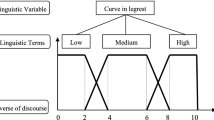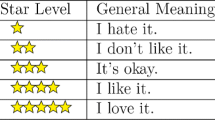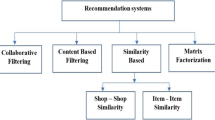Abstract
Online product reviews significantly impact the online purchase decisions of consumers. However, extant decision support models have neglected the randomness and fuzziness of online reviews and the interrelationships among product features. This study presents an integrated decision support model that can help customers discover desirable products online. This proposed model encompasses three modules: information acquisition, information transformation, and integration model. We use the information acquisition module to gather linguistic intuitionistic fuzzy information in each review through sentiment analysis. We also apply the information transformation module to convert the linguistic intuitionistic fuzzy information into linguistic intuitionistic normal clouds (LINCs). The integration module is employed to obtain the overall LINCs for each product. A ranked list of alternative products is determined. A case study on Taobao.com is then provided to illustrate the effectiveness and feasibility of the proposal, along with sensitivity and comparison analyses, to verify its stability and superiority. Finally, conclusions and future research directions are suggested.





Similar content being viewed by others
References
Liu, K., Luo, X., Zhang, L.: Evaluation of China’s B2C e-commerce website: an analysis of factors that influence online buying decision. Int. J. Multimed. Ubiquitous Eng. 11(3), 143–156 (2016)
Chen, X., Xue, Y., Zhao, H.Y., Lu, X., Hu, X.H., Ma, Z.H.: A novel feature extraction methodology for sentiment analysis of product reviews. Neural Comput. Appl. (2018). https://doi.org/10.1007/s00521-00018-03477-00522
Büschken, J., Allenby, G.M.: Sentence-based text analysis for customer reviews. Market. Sci. 35(6), 953–975 (2016)
Zhou, F., Jiao, J.R., Yang, X.J., Lei, B.: Augmenting feature model through customer preference mining by hybrid sentiment analysis. Expert Syst. Appl. 89, 306–317 (2017)
Gao, B., Hu, N., Bose, I.: Follow the herd or be myself? An analysis of consistency in behavior of reviewers and helpfulness of their reviews. Decis. Support Syst. 95, 1–11 (2017)
Gavilan, D., Avello, M., Martinez-Navarro, G.: The influence of online ratings and reviews on hotel booking consideration. Tour. Manag. 66, 53–61 (2018)
Chen, A., Lu, Y., Wang, B.: Customers’ purchase decision-making process in social commerce: a social learning perspective. Int. J. Inf. Manag. 37(6), 627–638 (2017)
Maslowska, E., Malthouse, E.C., Viswanathan, V.: Do customer reviews drive purchase decisions? The moderating roles of review exposure and price. Decis. Support Syst. 98, 1–9 (2017)
Wang, W., Tan, G., Wang, H.: Cross-domain comparison of algorithm performance in extracting aspect-based opinions from Chinese online reviews. Int. J. Mach. Learn. Cybernet. 8(3), 1053–1070 (2016)
Zhang, Z.Q., Ye, Q., Li, Y.J.: Literature review on sentiment analysis of online product reviews. J. Manag. Sci. China 13(6), 84–96 (2010)
Zhang, H.Y., Ji, P., Wang, J.Q., Chen, X.H.: A novel decision support model for satisfactory restaurants utilizing social information: a case study of TripAdvisor.com. Tour. Manag. 59, 281–297 (2017)
Liu, Y., Bi, J.W., Fan, Z.P.: Ranking products through online reviews: a method based on sentiment analysis technique and intuitionistic fuzzy set theory. Inf. Fusion. 36, 149–161 (2017)
Levy, S.E., Duan, W.J., Boo, S.Y.: An analysis of one-star online reviews and responses in the Washington, D.C., lodging market. Cornell Hosp. Q. 54(1), 49–63 (2013)
Xu, H., Fan, Z.P., Liu, Y., Peng, W.L., Yu, Y.Y.: A method for evaluating service quality with hesitant fuzzy linguistic information. Int. J. Fuzzy Syst. 20(5), 1523–1538 (2018)
Kahraman, C., Onar, S.Ç., Öztayşi, B.: B2C marketplace prioritization using hesitant fuzzy linguistic AHP. Int. J. Fuzzy Syst. 20(7), 2202–2215 (2017)
Zhang, H.M.: Linguistic intuitionistic fuzzy sets and application in MAGDM. J. Appl. Math. 2014, 1–11 (2014)
Peng, H.G., Zhang, H.Y., Wang, J.Q.: Cloud decision support model for selecting hotels on TripAdvisor.com with probabilistic linguistic information. Int. J. Hosp. Manag. 68, 124–138 (2018)
Bonferroni, C.: Sulle medie multiple di potenze. Bolletino dell`Unione Matematica Italiana 5, 267–270 (1950)
Keshavarz, H., Abadeh, M.S.: ALGA: adaptive lexicon learning using genetic algorithm for sentiment analysis of microblogs. Knowl. Based Syst. 122, 1–16 (2017)
Singh, J.P., Irani, S., Rana, N.P., Dwivedi, Y.K., Saumya, S., Kumar Roy, P.: Predicting the “helpfulness” of online consumer reviews. J. Bus. Res. 70, 346–355 (2017)
Lau, R.Y.K., Zhang, W., Xu, W.: Parallel aspect-oriented sentiment analysis for sales forecasting with big data. Prod. Oper. Manag. 27(10), 1775–1794 (2018)
Fan, Z.P., Che, Y.J., Chen, Z.Y.: Product sales forecasting using online reviews and historical sales data: a method combining the Bass model and sentiment analysis. J. Bus. Res. 74, 90–100 (2017)
Khan, F.H., Qamar, U., Bashir, S.: SWIMS: semi-supervised subjective feature weighting and intelligent model selection for sentiment analysis. Knowl. Based Syst. 100, 97–111 (2016)
Agarwal, B., Poria, S., Mittal, N., Gelbukh, A., Hussain, A.: Concept-level sentiment analysis with dependency-based semantic parsing: a novel approach. Cogn. Comput. 7(4), 487–499 (2015)
Xia, Y., Cambria, E., Hussain, A., Zhao, H.: Word polarity disambiguation using bayesian model and opinion-level features. Cogn. Comput. 7(3), 369–380 (2014)
Guo, Y., Barnes, S.J., Jia, Q.: Mining meaning from online ratings and reviews: tourist satisfaction analysis using latent dirichlet allocation. Tour. Manag. 59, 467–483 (2017)
Loughran, T., Mcdonald, B.: When is a liability not a liability? Textual analysis, dictionaries, and 10-ks. J. Finance 66(1), 35–65 (2011)
Thompson, J.J., Leung, B.H.M., Blair, M.R., Taboada, M.: Sentiment analysis of player chat messaging in the video game StarCraft 2: extending a lexicon-based model. Knowl. Based Syst. 137, 149–162 (2017)
Liu, X., Singh, P.V., Srinivasan, K.: A structured analysis of unstructured big data by leveraging cloud computing. Market. Sci. 35(3), 363–388 (2016)
Chan, I.C.C., Lam, L.W., Chow, C.W.C., Fong, L.H.N., Law, R.: The effect of online reviews on hotel booking intention: the role of reader-reviewer similarity. Int. J. Hosp. Manag. 66, 54–65 (2017)
Sparks, B.A., So, K.K.F., Bradley, G.L.: Responding to negative online reviews: the effects of hotel responses on customer inferences of trust and concern. Tour. Manag. 53, 74–85 (2016)
Yang, C., Yu, X., Liu, Y., Nie, Y., Wang, Y.: Collaborative filtering with weighted opinion aspects. Neurocomputing 210(C), 185–196 (2016)
Scholz, M., Pfeiffer, J., Rothlauf, F.: Using PageRank for non-personalized default rankings in dynamic markets. Eur. J. Oper. Res. 260(1), 388–401 (2017)
Fan, Z.P., Xi, Y., Liu, Y.: Supporting consumer’s purchase decision: a method for ranking products based on online multi-attribute product ratings. Soft. Comput. 22(16), 5247–5261 (2018)
Saranya, T.: Mining features and ranking products from online customer reviews. Int. J. Eng. Res. Technol. 2(10), 643–648 (2013)
Yang, X., Yang, G., Wu, J.: Integrating rich and heterogeneous information to design a ranking system for multiple products. Decis. Support Syst. 84, 117–133 (2016)
Najmi, E., Hashmi, K., Malik, Z., Rezgui, A., Khan, H.U.: CAPRA: a comprehensive approach to product ranking using customer reviews. Computing 97(8), 843–867 (2015)
Ji, P., Zhang, H., Wang, J.: A fuzzy decision support model with sentiment analysis for items comparison in e-commerce: the case study of PConline. IEEE Trans. Syst. Man Cybernet. Syst. (2018). https://doi.org/10.1109/tsmc.2018.2875163
Peng, Y., Kou, G., Li, J.: A fuzzy PROMETHEE approach for mining customer reviews in Chinese. Arab. J. Sci. Eng. 39(6), 5245–5252 (2014)
Delgado, M., Verdegay, J.L., Vila, M.A.: Linguistic decision-making models. Int. J. Intell. Syst. 7(5), 479–492 (1992)
Xu, Z.S.: A method based on linguistic aggregation operators for group decision making with linguistic preference relations. Inf. Sci. 166(1–4), 19–30 (2004)
Xu, Z.S.: A note on linguistic hybrid arithmetic averaging operator in multiple attribute group decision making with linguistic information. Group Decis. Negot. 15(6), 593–604 (2006)
Li, D., Liu, C., Gan, W.: A new cognitive model: cloud model. Int. J. Intell. Syst. 24(3), 357–375 (2009)
Zhou, W., He, J.M.: Intuitionistic fuzzy normalized weighted Bonferroni mean and its application in multi-criteria decision making. J. Appl. Math. 1110-757x, 1–16 (2012)
Wang, J.Q., Wu, J.T., Wang, J., Zhang, H.Y., Chen, X.H.: Interval-valued hesitant fuzzy linguistic sets and their applications in multi-criteria decision-making problems. Inf. Sci. 288, 55–72 (2014)
Wang, H., Feng, Y.: On multiple attribute group decision making with linguistic assessment information based on cloud model. Control Decis. 20(6), 679–685 (2005)
Wang, J., Peng, L., Zhang, H., Chen, X.: Method of multi-criteria group decision-making based on cloud aggregation operators with linguistic information. Inf. Sci. 274, 177–191 (2014)
Peng, H.G., Wang, J.Q.: Cloud decision model for selecting sustainable energy crop based on linguistic intuitionistic information. Int. J. Syst. Sci. 48(15), 3316–3333 (2017)
Wang, J., Peng, J., Zhang, H., Liu, T., Chen, X.: An uncertain linguistic multi-criteria group decision-making method based on a cloud model. Group Decis. Negot. 24(1), 171–192 (2014)
Wang, J.Q., Yang, W.E.: Multiple criteria group decision making method based on intuitionistic normal cloud by Monte Carlo simulation. Syst. Eng. Theory Pract. 33(11), 2859–2865 (2013)
Ma, H., Hu, Z.: Recommend trustworthy services using interval numbers of four parameters via cloud model for potential users. Front. Comput. Sci. 9(6), 887–903 (2015)
Peng, H.G., Wang, X.K., Wang, T.L., Wang, J.Q.: Multi-criteria game model based on the pairwise comparisons of strategies with Z-numbers. Appl. Soft Comput. 74, 451–465 (2019)
Peng, H.G., Wang, J.Q.: A multicriteria group decision-making method based on the normal cloud model with Zadeh’s Z-numbers. IEEE Transact. Fuzzy Syst. 26(6), 3246–3260 (2018)
Liang, R.X., Wang, J.Q., Li, L.: Multi-criteria group decision-making method based on interdependent inputs of single-valued trapezoidal neutrosophic information. Neural Comput. Appl. 30, 241–260 (2018)
Shannon, C.E.A.: A mathematical theory of communication. AT&T Technol. J. ACM Sigmob. Mob. Comput. Commun. Rev. 5(1), 3–55 (2001)
Chen, Z.C., Liu, P.H., Pei, Z.: An approach to multiple attribute group decision making based on linguistic intuitionistic fuzzy numbers. Int. J. Comput. Intell. Syst. 8(4), 747–760 (2015)
Liu, P.D., Qin, X.Y.: Power average operators of linguistic intuitionistic fuzzy numbers and their application to multiple-attribute decision making. J. Intell. Fuzzy Syst. 32(1), 1029–1043 (2017)
Liu, P.D., Qin, X.Y.: Maclaurin symmetric mean operators of linguistic intuitionistic fuzzy numbers and their application to multiple-attribute decision-making. J. Exp. Theor. Artif. Intell. 29(6), 1173–1202 (2017)
Peng, H.G., Wang, J.Q., Cheng, P.F.: A linguistic intuitionistic multi-criteria decision-making method based on the Frank Heronian mean operator and its application in evaluating coal mine safety. Int. J. Mach. Learn. Cybernet. 9(6), 1053–1068 (2017)
Zhang, H.Y., Ji, P., Wang, J.Q., Chen, X.H.: A neutrosophic normal cloud and its application in decision-making. Cogn. Comput. 8(4), 649–669 (2016)
Acknowledgements
The authors would like to thank the editors and anonymous reviewers for their great help on this study. This work was supported by the Fundamental Research Funds for the Central Universities of Central South University (No. 502211710).
Author information
Authors and Affiliations
Corresponding author
Ethics declarations
Conflict of interest
The authors declare that there is no conflict of interest regarding the publication of this paper.
Appendix A: Formula of LINCAA and LINCNWBM Operators
Appendix A: Formula of LINCAA and LINCNWBM Operators
Let \( \gamma_{ij}^{k} = \left( {\left( {Ex_{ij}^{k} ,En_{ij}^{k} ,He_{ij}^{k} } \right),\left( {ex_{ij}^{k} ,en_{ij}^{k} ,he_{ij}^{k} } \right)} \right) \)\( \left( {k = 1,2, \cdots ,q_{i} } \right) \) be a collection of transformed LINCs from the kth online review concerning alternative Ai under product feature Cj. Let \( U = [ {\text{X}}_{\hbox{min} } , {\text{X}}_{\hbox{min} } ] \) be an effective domain. Note that the weight of each online review is equal to \( {1 \mathord{\left/ {\vphantom {1 {q_{i} }}} \right. \kern-0pt} {q_{i} }} \). The overall evaluation value \( \gamma_{ij}^{{}} = \left( {\left( {Ex_{ij}^{{}} ,En_{ij}^{{}} ,He_{ij}^{{}} } \right),\left( {ex_{ij}^{{}} ,en_{ij}^{{}} ,he_{ij}^{{}} } \right)} \right) \) concerning alternative Ai under product feature Cj can be constructed by aggregating all \( \gamma_{ij}^{k} \) of each online review with the LINCAA operator.
The overall LINC information of each alternative product \( \gamma_{i}^{{}} \) can be calculated by aggregating all \( \gamma_{ij}^{{}} \) with the LINCNWBM operator by considering the interrelationships among product features. The weight vectors of product features are obtained by using the entropy-weighted method, denoted as \( w = \left( {w_{1} ,w_{2} , \ldots ,w_{m} } \right)^{\text{T}} \).
The aggregated results after using Eqs. (10) and (11) are still LINCs and satisfy the properties of reducibility, commutativity, idempotency, monotonicity and boundedness. The processes proving such findings are omitted here.
Rights and permissions
About this article
Cite this article
Liang, R., Wang, Jq. A Linguistic Intuitionistic Cloud Decision Support Model with Sentiment Analysis for Product Selection in E-commerce. Int. J. Fuzzy Syst. 21, 963–977 (2019). https://doi.org/10.1007/s40815-019-00606-0
Received:
Revised:
Accepted:
Published:
Issue Date:
DOI: https://doi.org/10.1007/s40815-019-00606-0




